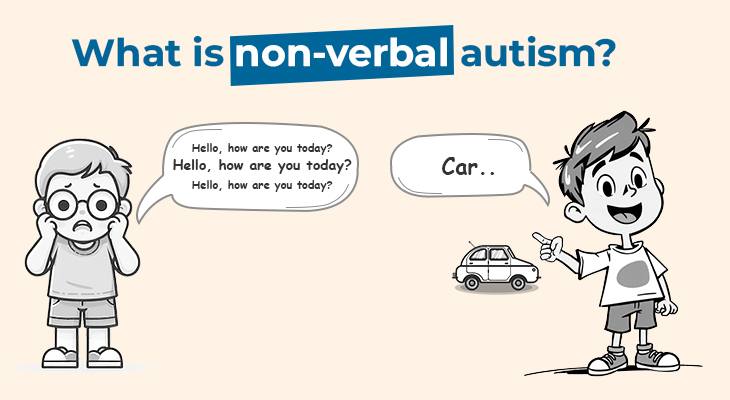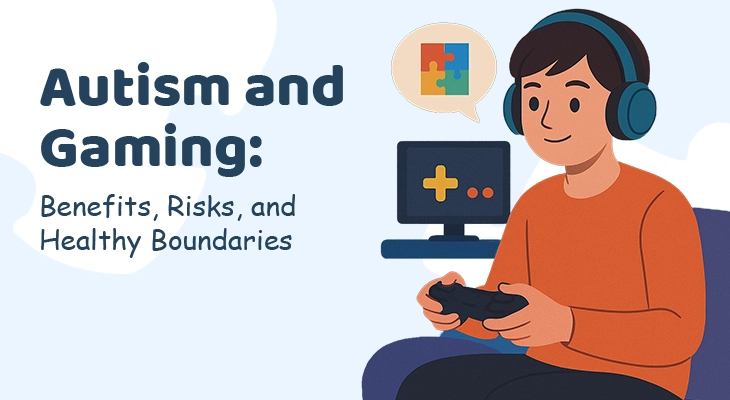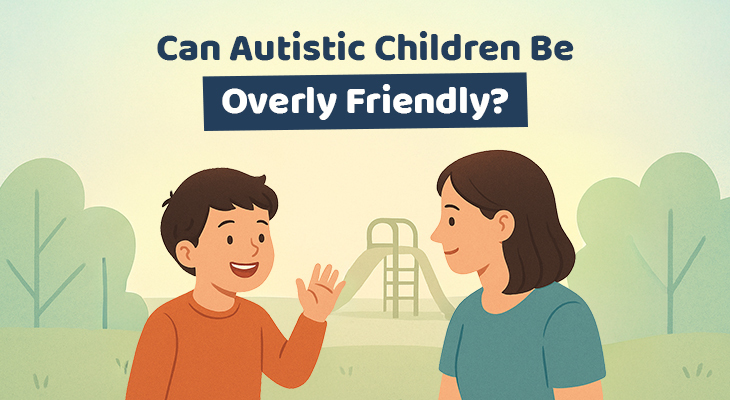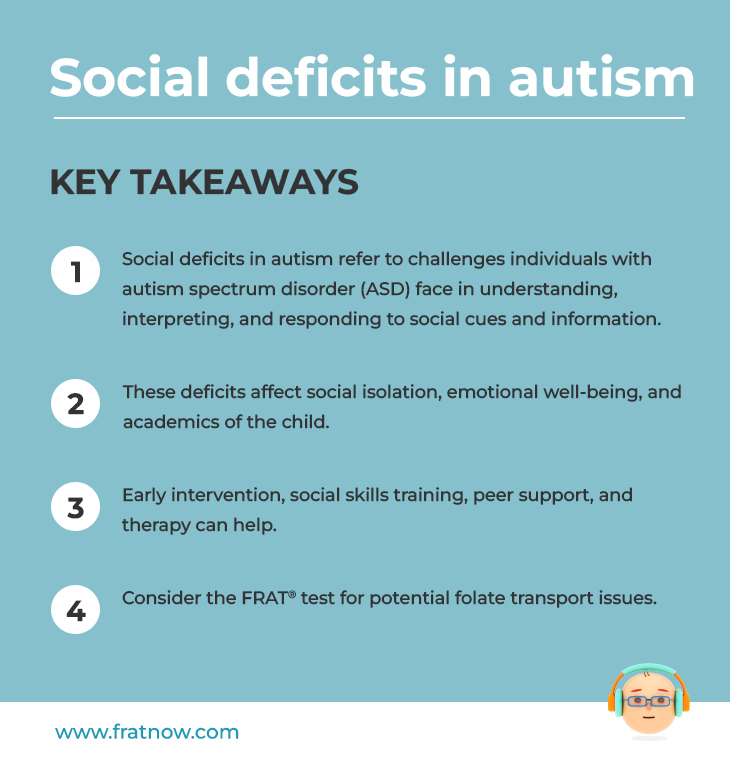
Download Download & share this Knowledge card in your network [Free Download]
What Does Social Deficits In Autism Mean?
Social deficits in autism refer to challenges individuals with autism spectrum disorder (ASD) face in understanding, interpreting, and responding to social cues and information. Social deficits can manifest in various ways. For example, they may have difficulty interpreting facial expressions, understanding body language, or recognizing social cues. They may find it difficult to engage in back-and-forth conversations, share emotions, or empathize with others. These deficits can significantly impact their ability to form and maintain relationships, engage in social interactions, and navigate social situations.
In this blog we will explore the key social deficits, their impact and strategies for addressing them.
Table of Contents
- What Does Social Deficits In Autism Mean?
- What Are The Key Social Deficits In Autism?
- Impact of Social Deficits on Individuals with Autism
- Strategies for Addressing Social Deficits in Autism
- Early Detection and Intervention for Social Deficits in Autism
- The FRAT® Test: A Potential Tool For Early Identification
- Did You Know?
- Conclusion
- References
What Are The Key Social Deficits In Autism?
Now that we have a basic understanding of social deficits in autism, let’s delve deeper into some of the key challenges individuals with ASD face in the social realm. In this section, we will explore specific examples of social deficits, including challenges with social cues, difficulty initiating and maintaining relationships, limited empathy, and repetitive behaviors.
[1] Challenges With Social Cues
Individuals with autism spectrum disorder (ASD) often face significant challenges when it comes to understanding and interpreting social cues. These cues, which include facial expressions, body language, and tone of voice, are essential for effective communication and social interaction. Here are some specific examples of challenges with social cues in autism:
-
Difficulty Recognizing Facial Expressions
Individuals with autism may struggle to accurately interpret facial expressions, leading to misunderstandings in social situations. For example, they may have trouble differentiating between a smile indicating happiness and a smile indicating sarcasm.
-
Misinterpreting Body Language
Body language is a crucial component of social communication. Individuals with autism may have difficulty understanding gestures, posture, and other nonverbal cues, which can lead to misinterpretations and social blunders. For example, imagine a child with autism approaching a new classmate. The classmate extends their hand for a handshake, but the child with autism might misinterpret this gesture as a threat or aggression, leading them to step back or avoid the interaction.
-
Challenges With Eye Contact
Maintaining appropriate eye contact is important for social interaction. Individuals with autism may avoid eye contact or have difficulty making and sustaining eye contact, which can be perceived as rude or dismissive. For example, a child with autism might look away from a teacher or classmate during a conversation, even when directly spoken to.
-
Difficulty Understanding Sarcasm And Humor
Sarcasm and humor often rely on subtle social cues that can be difficult for individuals with autism to interpret. This can lead to misunderstandings and social isolation. For example, a teacher might say sarcastically, “That’s a great idea,” in response to a student’s incorrect answer. A child with autism may literally interpret the statement, believing that the teacher genuinely thinks the idea is great.
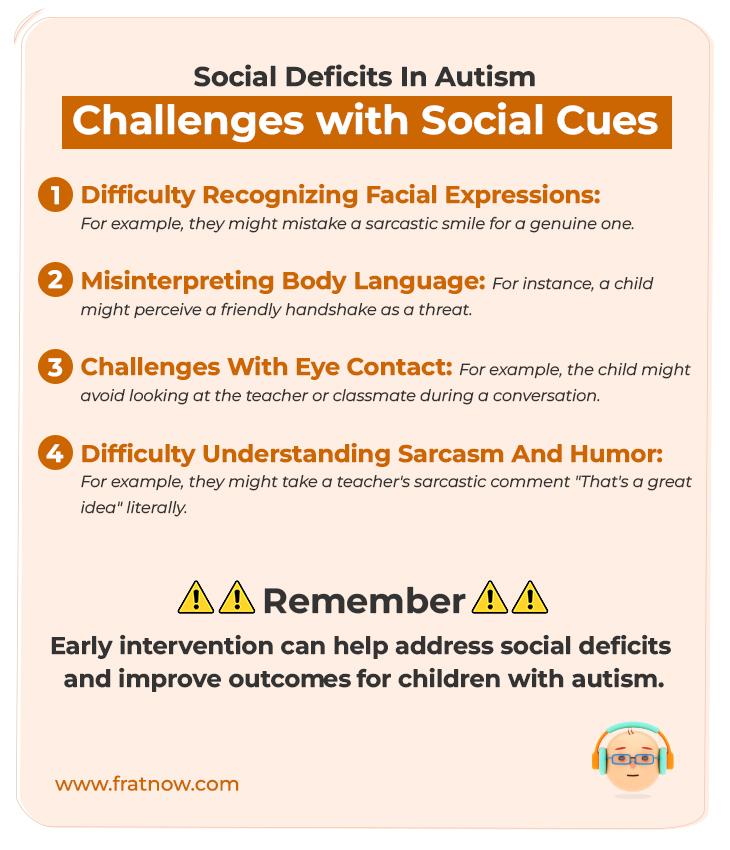
Download Download & share this infograph card in your network [Free Download]
[2] Limited Empathy
Individuals with autism spectrum disorder (ASD) often experience difficulties with empathy, which is the ability to understand and share the feelings of others. This limited empathy can impact their social interactions and relationships in several ways:
-
Misunderstandings and Misinterpretations
Individuals with ASD may struggle to identify and interpret the emotions of others, leading to misunderstandings and misinterpretations. For instance, a child with autism might misinterpret a friend’s furrowed brow as a sign of anger, even if the friend is simply concentrating. This misunderstanding could lead to the child avoiding the friend or becoming upset themselves.
-
Perspective-taking
They may have difficulty taking the perspective of others and understanding their point of view, which can hinder their ability to empathize. For example, a child with autism might not understand why their sibling is upset after losing a game. They may focus on their own disappointment without considering their sibling’s feelings.
-
Reduced Emotional Expressiveness
Individuals with ASD may have limited emotional expressiveness, making it difficult for others to understand and connect with their feelings. For example, a child with autism might not express joy or excitement in the same way as their peers. They may appear more reserved or indifferent, making it difficult for others to understand their emotions.
-
Difficulty Responding To The Emotions Of Others
They may struggle to respond appropriately to the emotions of others, such as offering comfort or support when someone is upset. For example, if a friend is crying, a child with autism might not know how to respond appropriately. They may avoid the situation, offer inappropriate advice, or simply not understand the friend’s distress.
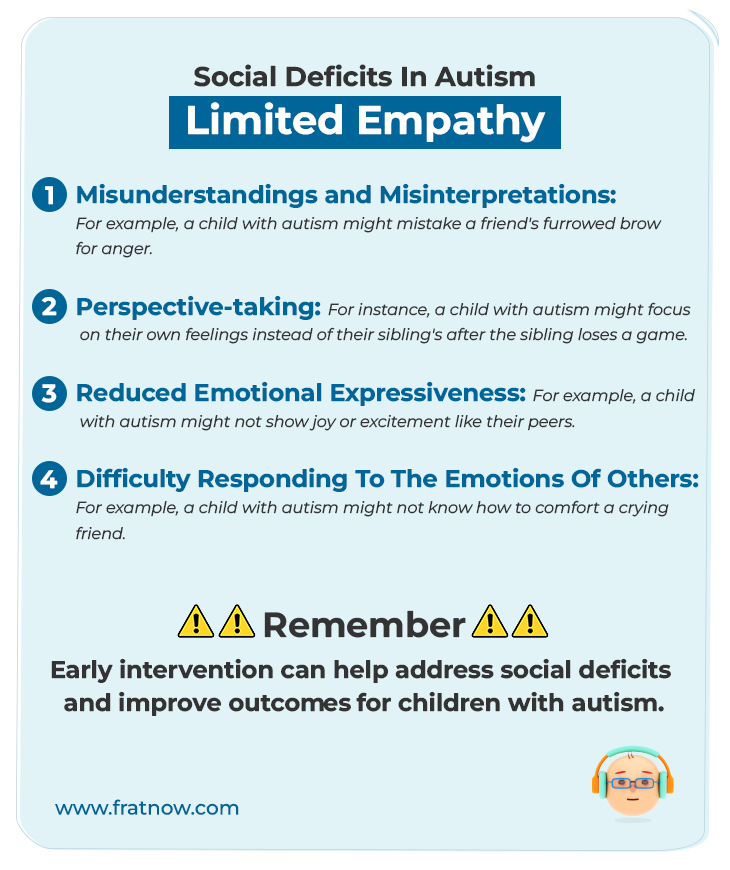
Download Download & share this infograph card in your network [Free Download]
[3] Repetitive Behaviors
Repetitive behaviors are a hallmark characteristic of autism spectrum disorder (ASD) and can significantly impact an individual’s daily life. These behaviors often involve repetitive actions, routines, or interests. Here are some common examples of repetitive behaviors in autism:
-
Stimming
This refers to repetitive self-stimulatory behaviors, such as rocking, flapping hands, or twirling objects. For instance, a child with autism might flap their hands repeatedly when excited or overwhelmed.
-
Insistence On Sameness
Individuals with autism may have a strong need for routines and predictability, and may become distressed when changes occur. For instance, a child with autism might insist on always eating the same food for breakfast or taking the same route to school.
-
Repetitive Speech or Vocalizations
This can include echolalia (repeating words or phrases), stereotyped phrases, or unusual vocalizations. For example, a child with autism might repeat phrases they’ve heard, such as lines from a movie or TV show.
-
Narrow Interests
Individuals with autism may have intense, focused interests that they engage in repeatedly. For instance, a child with autism might have an intense interest in trains, spending hours studying train schedules, collecting train toys, or drawing pictures of trains.
-
Preoccupation With Objects
They may have a strong attachment to certain objects or materials. For example, a child with autism might have a strong attachment to a particular stuffed animal or toy, carrying it everywhere and becoming distressed if it is lost or taken away.
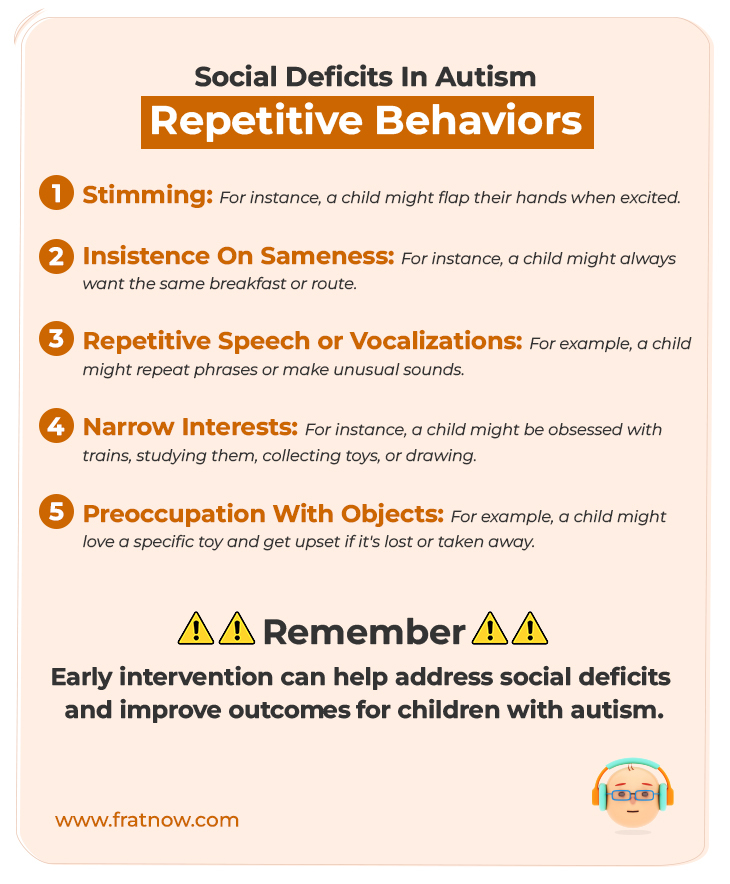
Download Download & share this infograph card in your network [Free Download]
[4] Sensory Sensitivities
Sensory sensitivities are a common feature of autism spectrum disorder (ASD) and can significantly impact an individual’s daily life. These sensitivities can involve any of the five senses: sight, hearing, touch, taste, or smell. Common sensory sensitivities in autism include:
-
Over-Sensitivity
Individuals with autism may be overly sensitive to certain sensory stimuli, such as loud noises, bright lights, or rough textures. They may avoid certain sensory stimuli, such as particular sounds, textures, or smells. For instance, a child with autism might become overwhelmed and distressed by loud noises, such as sirens or construction sounds. This can lead to anxiety, distress, and avoidance behaviors.
-
Under-Sensitivity
Some individuals with autism may be less sensitive to certain sensory stimuli, leading to seeking out sensory input or engaging in repetitive behaviors. These individuals may actively seek out sensory experiences such as spinning, rocking, or chewing on objects. For example, a child with autism might have a decreased sensitivity to pain. This could lead them to engage in behaviors that could cause injury, such as biting their own hand or banging their head against a wall.
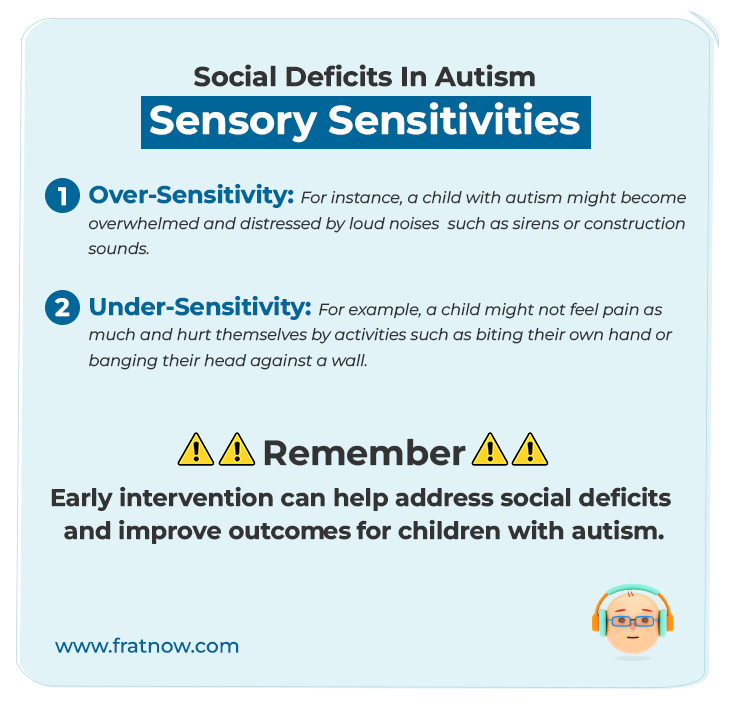
Download Download & share this infograph card in your network [Free Download]
[5] Difficulty Initiating And Maintaining Relationships
Individuals with autism spectrum disorder (ASD) often face challenges in initiating and maintaining relationships. These difficulties can arise from all the factors listed above and can lead to feelings of isolation, loneliness, and difficulty forming friendships.
Impact of Social Deficits on Individuals with Autism
Social deficits in autism can have a profound impact on individuals with ASD, affecting their social isolation, emotional well-being, and academic challenges.
Social Isolation
Individuals with autism may experience social isolation due to their difficulties in forming and maintaining relationships. This isolation can lead to feelings of loneliness, rejection, and a lack of belonging. Social isolation can also contribute to low self-esteem and self-worth.
Emotional Well-Being
Social deficits can have a significant impact on emotional well-being. Individuals with autism may struggle with anxiety, depression, and other mental health issues due to challenges in social interactions. These emotional difficulties can further exacerbate social isolation and contribute to a negative cycle.
Academic Challenges
Social deficits can also impact academic performance. Difficulty in communicating with peers and teachers, understanding social cues in the classroom, and working collaboratively can hinder academic success. IAdditionally, social isolation and emotional difficulties can affect concentration, motivation, and overall academic engagement.
Strategies for Addressing Social Deficits in Autism
By implementing these strategies, individuals with autism can develop their social skills, improve their emotional well-being, and enhance their overall quality of life. Let’s look at some of the strategies:
Social Skills Training
Social skills training is a crucial component of addressing social deficits in autism. This involves teaching individuals with ASD specific social skills, such as:
- Communication skills: How to initiate and maintain conversations, express emotions, and understand nonverbal cues.
- Problem-solving skills: How to identify and resolve social conflicts.
- Empathy and perspective-taking: How to understand and respond to the emotions and perspectives of others.
- Social etiquette: How to follow social norms and expectations.
Social skills training can be conducted in individual or group settings and can involve role-playing, modeling, and providing feedback.
Peer Support Groups
Peer support groups provide a safe and supportive environment for individuals with autism to connect with others who share similar experiences. These groups can offer opportunities for social interaction, emotional support, and information sharing.
Inclusive Education
Inclusive education settings can help individuals with autism develop social skills and learn to interact with their peers. By providing a supportive and inclusive environment, schools can foster social development and help individuals with autism feel more connected to their classmates.
Therapeutic Interventions
Social skills training is a crucial component of addressing social deficits in autism. This involves teaching individuals with ASD
variety of therapeutic interventions can be helpful in addressing social deficits in autism, including:
- Applied Behavior Analysis (ABA): ABA is a behavioral therapy that can be used to teach social skills and address challenging behaviors.
- Speech therapy: Speech therapy can help individuals with autism improve their communication skills and social interactions.
- Occupational therapy: Occupational therapy can help individuals with autism develop daily living skills, including social skills.
- Cognitive-behavioral therapy (CBT): CBT can help individuals with autism manage anxiety, depression, and other emotional challenges that may impact social interactions.
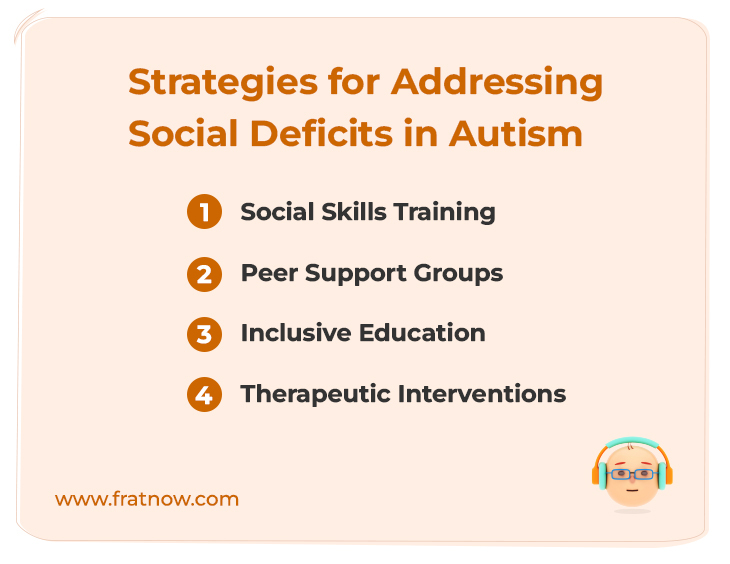
Download Download & share this infograph card in your network [Free Download]
Early Detection and Intervention for Social Deficits in Autism
Early detection of autism spectrum disorder (ASD) is crucial for addressing social deficits and improving outcomes. When autism is diagnosed early, children can receive appropriate interventions that can help them develop essential social skills and reduce the impact of social challenges.
Here’s why early intervention is important:
- Brain plasticity: The human brain is most malleable during early childhood, making it an ideal time for interventions to address developmental challenges, including social deficits.
- Skill development: Early intervention can help children with autism develop essential social skills , such as communication, empathy, and perspective-taking, which can improve their social interactions.
- Reduced social isolation: Early intervention can help prevent social isolation by providing opportunities for social interaction and skill development.
- Improved emotional well-being: Addressing social deficits early on can help reduce anxiety, depression, and other emotional challenges associated with autism.
- Enhanced academic and occupational outcomes: Early intervention can improve academic performance and increase the likelihood of successful employment and independent living.
The FRAT® Test: A Potential Tool For Early Identification
While various strategies can address social deficits, early identification is crucial for optimal outcomes. In some cases, social deficits in children with autism may be linked to folate deficiency. The Folate Receptor Autoantibody Test (FRAT®) can be a valuable tool in identifying potential folate transport issues that could be contributing to and other developmental concerns in children with autism. Read our blog What is FRAT® and the role FRAT® plays in Autism to discover more about this tool and its importance in the early identification of autism.
Here’s why the FRAT® test is relevant:
- Folate deficiency and Autism: Research suggests a potential link between folate deficiency and certain developmental issues in children with autism.
- Folate and the nervous system: Folate is a vital vitamin for proper nervous system function and development.
- FRAT® and Folate Transport: The FRAT® test specifically detects autoantibodies that may interfere with folate transport into the brain.
Early detection and intervention are key. If the FRAT® test identifies potential folate transport issues, a healthcare professional can recommend appropriate treatment plans, such as alternate folate supplementation, to address the underlying cause and potentially improve developmental outcomes.
Conclusion
Social deficits are a common challenge for individuals with autism spectrum disorder (ASD). By understanding these challenges and implementing appropriate strategies, we can support individuals with autism in developing their social skills, improving their emotional well-being, and enhancing their overall quality of life.
Remember, early detection and intervention are key. If you have concerns about your child’s social development, consult with a healthcare professional for evaluation and support.

